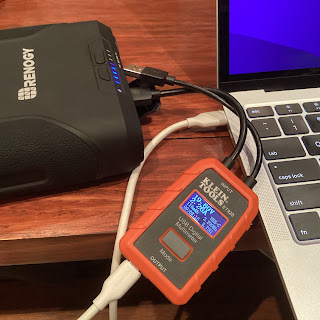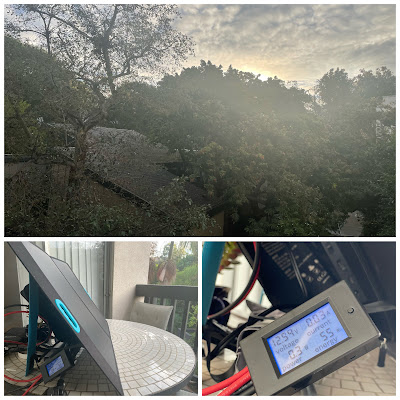Renogy Portable Solar Setup
 |
| Renogy power bank connected to MacBook Air |
The power bank comes with a Lyangel LY005SPS-200200U 40W (20V 2A) wall wort (5.5x2.1mm DC, positive pin negative shield). I used that to charge the bank to full (it arrived with a ~50% charge). So far I’ve tested wireless charging with an iPhone 12 Pro (works) and now through the Klein meter I have USB-C PD (1) connected to a MacBook Air and it’s supplying 19.73V 1.89A (36.7W). (The Mac sees it as a 60W charger.)
The power bank is a beast, about the size and heft of a dense hardback book. It comes with that AC adapter, a ~19" DC to DC cord (5.5x2.1mm (“DC5521”) male connectors on both ends, about 10mm long), a set of (8) adapter tips (5.5x2.1mm female, and 8 various male ends), a soft case with a pouch for accessories, and a manual. It charges via the 5.5x2.1mm DC port. It has a mix of USB ports (including an “in/out” C port), and a 12V “cigar lighter” socket limited to 150W. It charges via DC (18-24V/4A) or that USB-C (1) port (DC5V/3A, 9V/3A, 12V/3A, 15V/3A, 20V/3A).
The panel comes packed simply, with everything bundled stored in a zippered pouch on the back of one panel. That pouch contains a permanently attached direct connection to the panel (about 36" long, terminating in MC4 connectors), an 80" MC4 to 5.5x2.1mm (male) adapter cable, an 80" 5.5x2.1mm male/male cable, another set of (8) DC plug adapters‡, and a manual. If using the built in converter (not sure if that’s the right terminology?), it will output DC via the 5.5x2.1mm port (up to 19V / 2.4A; 16V / 2.8A Max, ~45W), and/or one of the two USB ports (toggle between the A (5V / 2.4A Max, 12W) and C (non-PD, 5V / 3A Max, 15W) ports). I don’t have an irradiance meter (or digital light meter and convert foot candles or lux to W/m2?) or infrared thermometer, but I did pick up a meter and a set of MC4 cables I’m going to splice into it. Can’t wait until the sun’s out…
Day two: The first day was a bit disappointing. Put the panel up on my due-east facing balcony facing the rising sun. I eyeballed it at 130° which, as it turns out, was pretty much spot on (128° solar azimuth from my location at that time of day, according to the NOAA Solar Position Calculator ). The USB-C output settled in about 5.15V 1.78A (~9W); over one hour 45 minutes, the Klein recorded just over 16 Wh flowing into the power bank.
But. There are so many variables in that setup. How efficient is the USB converter built into the panel? What will the power bank accept via USB C from that panel? Is the Klein in any way interfering? The power bank is not USB-C PD; it should draw 3A at 5V and the panel should supply 3A, but I honestly don’t know enough about how USB-C charging works (especially in the absence of PDO negotiation).
Day two will see this HiLetgo DC 6.5-100V 0-20A LCD Display Digital Meter (which the included documentation identifies as a PZEM-031, a model number I’ve found numerous places) installed inline between the panel (MC4 direct outputs) and the power bank (using the MC4-to-5.5mm adapter supplied with the panel), I cut and stripped these cables (which fit, but just barely; 14AWG would probably have been a better choice, the 12AWG fits but the insulation makes things a very tight fit).
A note: I’m not wild about the display of the power bank. There are four blue LEDs to indicate charge state, but they bleed into each other, and it’s kind of hard to tell if you have two bars or four:
 |
| Picture of the charge status LEDs on the Renogy power bank |
This is after the Klein meter recorded 100 Wh of power transfer, about 38% of the capacity of the battery, so I’d expect two lights lit solid and one blinking (maybe?). I would kill for an LCD (or, dreaming, OLED) display that gave more information, especially regarding incoming (charging) wattage. The Zendure SuperTank Pro has a great display, and other, larger, solar generators typically include such information.
Day three: Sunrise was at 0648 this morning. I’m at approximately 72' MSL here, and my east-facing balcony is at the base of the Baldwin Hills (peak is 512' MSL). (I also have the overhang of the balcony above. Not an ideal solar situation.) The panel came alive around 0740, with a very minimal amount of power (~13V 0.03A 0.3W reported by the PZEM-031 digital meter). It showed 55 Wh generated yesterday, but the Renogy battery pack is at 100% so I’m not sure if that reflects the maximum power the panel could generate in the time it had in the sun, or merely what the battery could accept. (Looking at the meter again with the panel in full sunlight with no load (battery disconnected), I’m seeing voltage but no current, 0 watts, and 0 Wh logged since I reset the meter this morning. So, yeah, it appears the Wh record is only what was consumed, not what was available. (If I were being scientific about this I’d have a dummy load hooked up to eliminate the battery’s charge state as a variable, etc. But I’m not, because this is more of a practical question - how much can I charge / use this specific battery pack in my specific circumstances.)
So today I’m going to run it down as much as I can. At the moment it’s wirelessly charging my iPhone 12 Pro and supplying (per the Klein meter) 19.73V 2.29A (~45W) to a MacBook Air that’s also powering a 15.6" portable monitor; the Mac sees it as a 45W charger and coconutBattery reports it’s “charging with: 27.09 Watts.” 266 Wh capacity • 85% efficiency should get me down to about 50% after ~2.5 hours of this.
At 1042 the sun is no longer shining directly on the panel but there’s still enough light that the succulent is casting a shadow. Voltage has fallen to 19.3V. Will be interesting to see, tomorrow, with a thirty battery pack, how much I can actually extract from the sun during the ~3 hours of winter sun the balcony gets.
By 1253 after running the MacBook Air and monitor non-stop (and topping off my iPhone continuously via the wireless charger) for ~5 hours, the Renogy power bank is showing I think one light of charge remaining (the lights on either side have some bleed-through), and the Klein meter is showing 143 Wh transferred.
 |
| Sun starting to peak out over hill; panel in indirect sunlight; power meter showing 0.3W |
Day 4: We had rain overnight and the morning was uncharacteristically overcast, so, no solar experiments. Did manage to run the Renogy battery pack down all the way yesterday, so I should have a good test situation when the sun starts to cooperate again.
‡ 3.5x1.35mm (labeled “H”); 6.5x4.5x1.35mm (“A”); 5.5x2.5mm (“C”); 7.9x5.5mm (pin) (“Fordell”); 7.4x5.0mm (pin) (“K”); 4.5x3.0mm (pin) (“H”); 5.0x3.0mm (pin) (“Fordell”); 3.0x1.0mm (“L”).


Comments
Post a Comment